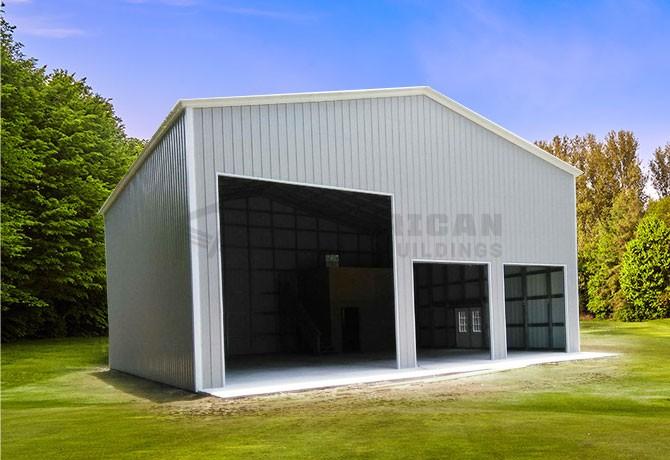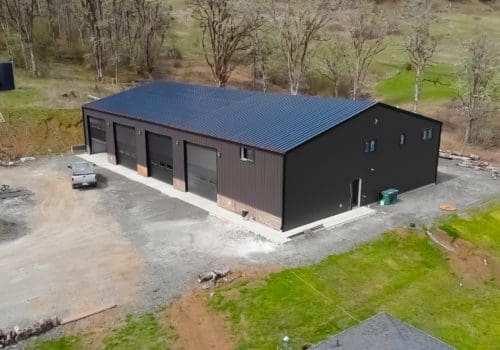Professional Guide to Steel Building Design: Making Best Use Of Effectiveness and Durability
Steel, with its phenomenal toughness, resilience, and adaptability, has actually emerged as a preferred alternative for contemporary building design. From optimizing design considerations to implementing affordable construction techniques, the trip towards making best use of performance and durability in steel structure style is a complex one, offering a mix of functional challenges and innovative options that propel the sector forward. steel buildings.
Benefits of Steel Buildings
Steel buildings provide unmatched longevity and cost-effectiveness compared to traditional construction products. The strength of steel provides exceptional structural honesty, making it a favored choice for structures that require to endure harsh climate conditions or hefty loads. Steel is very immune to insects, mold and mildew, and fire, guaranteeing a longer lifespan with marginal maintenance needs. Furthermore, steel is a sustainable product, as it is fully recyclable and can be repurposed at the end of its valuable life.
In regards to cost-effectiveness, steel buildings are frequently extra budget friendly than structures made from other products. The efficient building and construction process of steel structures can cause lowered labor expenses and much shorter task timelines. Steel's toughness also equates to reduce maintenance costs over time, as there is less need for replacements or repair work compared to typical structure products.
Style Factors To Consider for Performance
Provided the advantages of steel buildings in regards to sturdiness and cost-effectiveness, it is crucial to focus on style considerations that make best use of performance and long life. When making a steel structure for ideal effectiveness, aspects such as the insulation, alignment, and design must be very carefully taken into consideration. Reliable layouts can minimize product waste throughout building and improve the functionality of the structure. In addition, picking the best orientation can aid make best use of all-natural light exposure, lowering the demand for fabricated illumination and lowering power expenses.

Additionally, integrating energy-efficient systems, such as HVAC, lighting, and renewable resource resources, can even more improve the performance of steel structures. By integrating these design considerations, steel frameworks can accomplish optimal effectiveness and long life, offering lasting and cost-efficient options for different building projects.
Structural Honesty and Durability

Furthermore, the option of high-quality steel and coatings is essential for durability. Corrosion-resistant finishes protect against rust and degeneration, lengthening the life of the framework. Routine maintenance, consisting of evaluations for signs of wear or damage, is also critical for identifying and attending to issues prior to they compromise the structure's honesty. By prioritizing architectural stability in the style stage and throughout the building's lifespan, owners can ensure their steel frameworks stay safe, effective, and sturdy for years to find.
Cost-Effective Construction Approaches
Effective construction techniques play a pivotal role in managing expenses without jeopardizing the quality and stability of steel structure projects. Additionally, pre-engineered steel buildings are recognized for their resilience and require minimal maintenance, click here to read resulting in long-term price savings.
Another economical approach is the design-build approach, where the layout and construction stages are integrated. This method promotes cooperation in between the style and building groups, enhancing the procedure and minimizing delays and expense overruns (steel buildings). By including all stakeholders from the beginning, possible problems can be identified and resolved early, saving both money and time
Moreover, embracing sustainable construction methods, such as using recycled steel and incorporating energy-efficient features, can cause significant cost financial savings in the future. These methods not only minimize construction waste but also reduced functional costs through enhanced energy efficiency. Finally, implementing cost-effective building and construction methods is crucial for making best use of efficiency and making sure the durability of steel structure projects.
Maintenance Tips for Long Life
Proper maintenance practices are critical for ensuring the durability and structural stability of steel buildings. Regular evaluations are important to identify any indicators of corrosion, damage, or wear that can jeopardize the structure's toughness. As part of a detailed maintenance plan, it is very important to promptly address any kind of problems that emerge to stop them from rising and triggering much more substantial damages.

One more vital maintenance tip is to inspect the building's welds, links, and fasteners to guarantee they are protected and in great problem. Any type of loose or damaged elements ought to be repaired or replaced without delay to preserve the architectural honesty of the building. By applying a proactive upkeep regimen, steel building proprietors can make the most of the durability and efficiency of their structures.
Verdict
Finally, steel buildings supply various benefits such as durability, performance, and cost-effectiveness. By meticulously considering design elements, making certain architectural stability, and utilizing economical building and construction techniques, steel structures can be optimized for optimal effectiveness and long life. Routine upkeep is additionally essential to making sure the durability of a steel structure. In general, steel structures are a trustworthy and sturdy choice for various building projects.
From maximizing layout considerations to applying cost-effective building methods, the journey towards making the most of performance and long life in steel building style is a diverse one, providing a blend of functional obstacles and innovative options that thrust the sector forward.
Offered the benefits of steel buildings in terms of toughness and cost-effectiveness, it is vital to focus on layout factors to consider that make best use of performance and durability. When look at this web-site developing a steel building for optimal efficiency, factors such as the alignment, design, and insulation must be meticulously thought about. In verdict, implementing cost-effective building and construction techniques is important for optimizing performance and making sure the longevity of steel structure jobs.
By carefully taking into consideration design facets, making certain structural honesty, and making use of cost-efficient building and construction techniques, steel buildings can be maximized for optimal performance and durability.